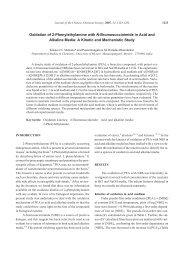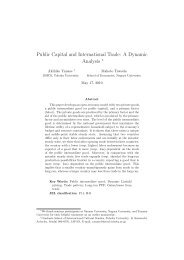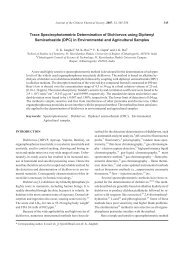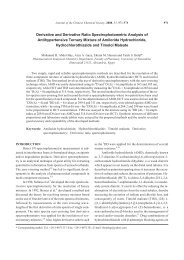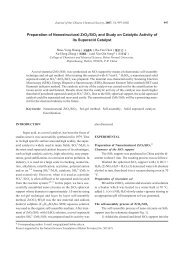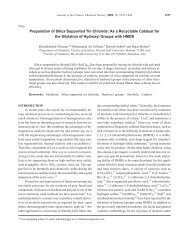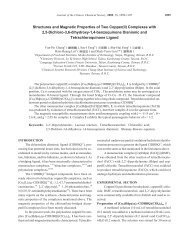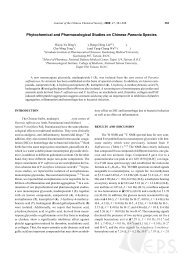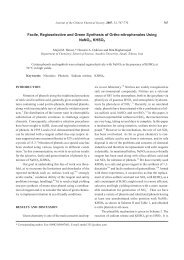Biotinylation of Peptides/Proteins using Biocytin Hydrazide
Biotinylation of Peptides/Proteins using Biocytin Hydrazide
Biotinylation of Peptides/Proteins using Biocytin Hydrazide
You also want an ePaper? Increase the reach of your titles
YUMPU automatically turns print PDFs into web optimized ePapers that Google loves.
<strong>Biotinylation</strong> <strong>of</strong> <strong>Peptides</strong>/<strong>Proteins</strong> <strong>using</strong> <strong>Biocytin</strong> <strong>Hydrazide</strong> J. Chin. Chem. Soc., Vol. 54, No. 2, 2007 543<br />
were detected at m/z 1667 (singly biotinylated) in the case<br />
<strong>of</strong> agiotensin I, at m/z 1904 (singly biotinylated) in the case<br />
<strong>of</strong> P14R, at m/z 1994 (singly biotinylated) in the case <strong>of</strong><br />
ACTH fragments 1-13, and at m/z 6105 (singly biotinylated),<br />
m/z 6475 (doubly biotinylated), m/z 6845 (triply<br />
biotinylated), m/z 7215 (quadruply biotinylated), m/z 7585<br />
(five biotinylations), m/z 7855 (six biotinylations), and at<br />
m/z 8325 (seven biotinylations) in the case <strong>of</strong> insulin. Since<br />
there is only one biotinylation detected in the case <strong>of</strong> angiotensin<br />
I and the sequence <strong>of</strong> angiotensin I (DRVYIHPFHL)<br />
contains no lysine residue, N-terminal or other animo acid<br />
residue besides lysine is biotinylated. Results from a<br />
MALDI-TOF post-source decay (PSD) study <strong>of</strong> m/z 1904<br />
(singly biotinylated P14R) described later together with that<br />
only one biotinylation was detected in the case <strong>of</strong> P14R<br />
Fig. 1. The MALDI-TOF spectra <strong>of</strong> intact and biotinylated<br />
peptides (angiotensin, P14R, ACTH fragment<br />
1-13, and insulin) at 65 C for 24 h: (I a)<br />
Angiotensin I in 10% TFA (v/v) aqueous solution<br />
without biocytin hydrazide; (I b) Angiotensin<br />
I in 10% TFA (v/v) aqueous solution with 1<br />
M biocytin hydrazide; (II a) P14R in 10% TFA<br />
(v/v) aqueous solution without biocytin hydrazide;<br />
(II b) P14R in 10% TFA (v/v) aqueous solution<br />
with 1 M biocytin hydrazide; (III a)<br />
ACTH fragment 1-13 in 10% TFA (v/v) aqueous<br />
solution without biocytin hydrazide; (III b)<br />
ACTH fragment 1-13 in 10% TFA (v/v) aqueous<br />
solution with 1 M biocytin hydrazide; (IV a)<br />
Insulin in PBS without biocytin hydrazide; (IV<br />
b) Insulin in PBS with 1 M biocytin hydrazide.<br />
Peptide solution (1 g/l) was processed with<br />
Zip-Tip packed with C18 resin before MALDI-<br />
TOF MS. CHCA was used as the matrix. Contaminant<br />
is marked by an asterisk.<br />
(PPPPPPPPPPPPPPR) indicate that it is the arginine residue<br />
<strong>of</strong> P14R which is biotinylated. In addition, PSD results<br />
(data not shown) <strong>of</strong> ACTH and angiotensin I show that the<br />
arginine side chain for both peptides is biotinylated. Since<br />
there are seven biotinylations detected in the case <strong>of</strong> insulin<br />
and the sequence <strong>of</strong> insulin (GIVEQCCASVCSLYQLEN-<br />
YCNFVNQHLCGSHLVEALYLVCGERGFFYTPKA)<br />
contains only one lysine, one arginine and two N-terminals,<br />
it seems that residues other than lysine or arginine can also<br />
react with biocytin hydrazide. It is noted that unlike the<br />
bisulfite-catalyzed (rate increases up to 100 times) transamination<br />
reaction <strong>of</strong> cytidine residues in DNA with biotin<br />
hydrazide, 2,7-11 addition <strong>of</strong> sodium bisulfite (1 M) only<br />
slightly increases the reaction rate <strong>of</strong> peptides/proteins<br />
with biocytin hydrazide (data not shown).<br />
The molecular ions <strong>of</strong> horse heart cytochrome c, hen<br />
egg white lysozyme, soybean trypsin inhibitor (SBTI), and<br />
bovine serum albumin (BSA) as well as their biotinylated<br />
ions are exhibited in Fig. 2. These proteins gain 370 Da<br />
upon condensation with one biocytin hydrazide molecule.<br />
Molecular masses <strong>of</strong> these biotinylated proteins produced<br />
by incubating proteins with biocytin hydrazide and the<br />
number <strong>of</strong> biocytin hydrazide molecules attached to the<br />
proteins are compiled in Table 1. The biotinylated ions<br />
were detected at m/z 12732, 13102, 13472, 13842, 14212,<br />
and 14582 (up to 6 biotinylations) in the case <strong>of</strong> cytochrome<br />
c, at m/z 14676, 15046, 15416, 15786, 16156, and<br />
16526 (up to 6 biotinylations) in the case <strong>of</strong> lysozyme, at<br />
m/z 20365, 20735, 21105, and 21475 (up to 4 biotinylations)<br />
in the case <strong>of</strong> SBTI, and m/z 72720 (approximately<br />
17 biotinylations) and m/z 83450 (approximately 46 biotinylations)<br />
in the case <strong>of</strong> BSA. In general, since there are<br />
mixtures <strong>of</strong> many biotinylated proteins with different biocytin<br />
hydrazide molecules attached, the peaks corresponding<br />
to biotinylated proteins are broader than their nonbiotinylated<br />
counterparts. Since there are more lysine residues<br />
than the total number <strong>of</strong> biotinylations <strong>of</strong> each protein,<br />
not all the lysine residues in each protein are reactive toward<br />
biocytin hydrazide.<br />
The MALDI-TOF spectra <strong>of</strong> the products produced<br />
by reacting insulin with 0.3 M <strong>of</strong> biocytin HCl, phenyl hydrazine,<br />
adipic dihydrazide, 2-iminobiotin, or 2-iminobiotin<br />
hydrazide at 65 C for 5.5 h are shown in Fig. 3, and<br />
masses <strong>of</strong> the various biotinylated insulins are compiled in<br />
Table 1. An aqueous solution <strong>of</strong> 50% (v/v) acetonitrile containing<br />
1% (v/v) TFA was used as the solvent to solubilize<br />
all the materials. Insulin should gain 355, 241, 226, 157,



